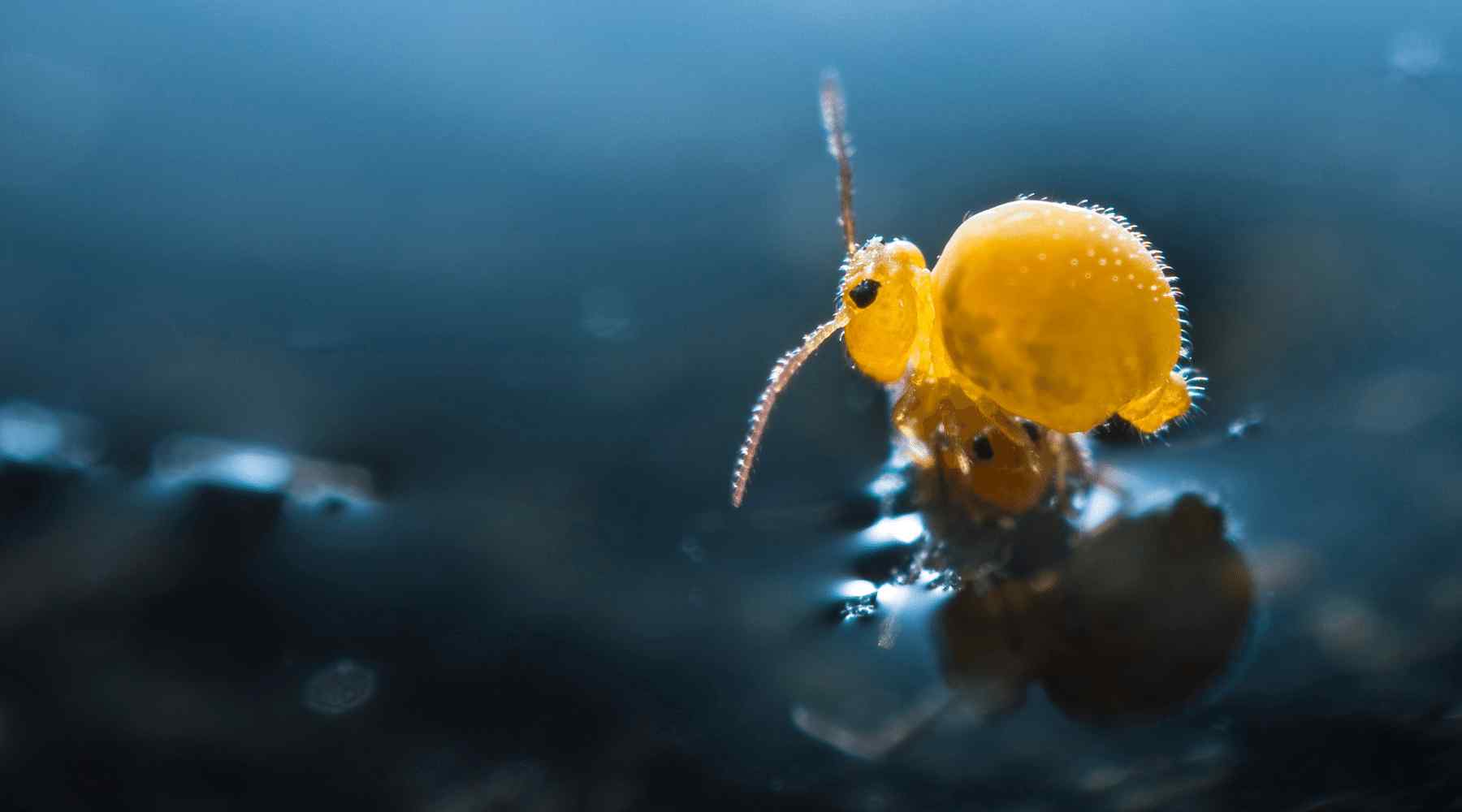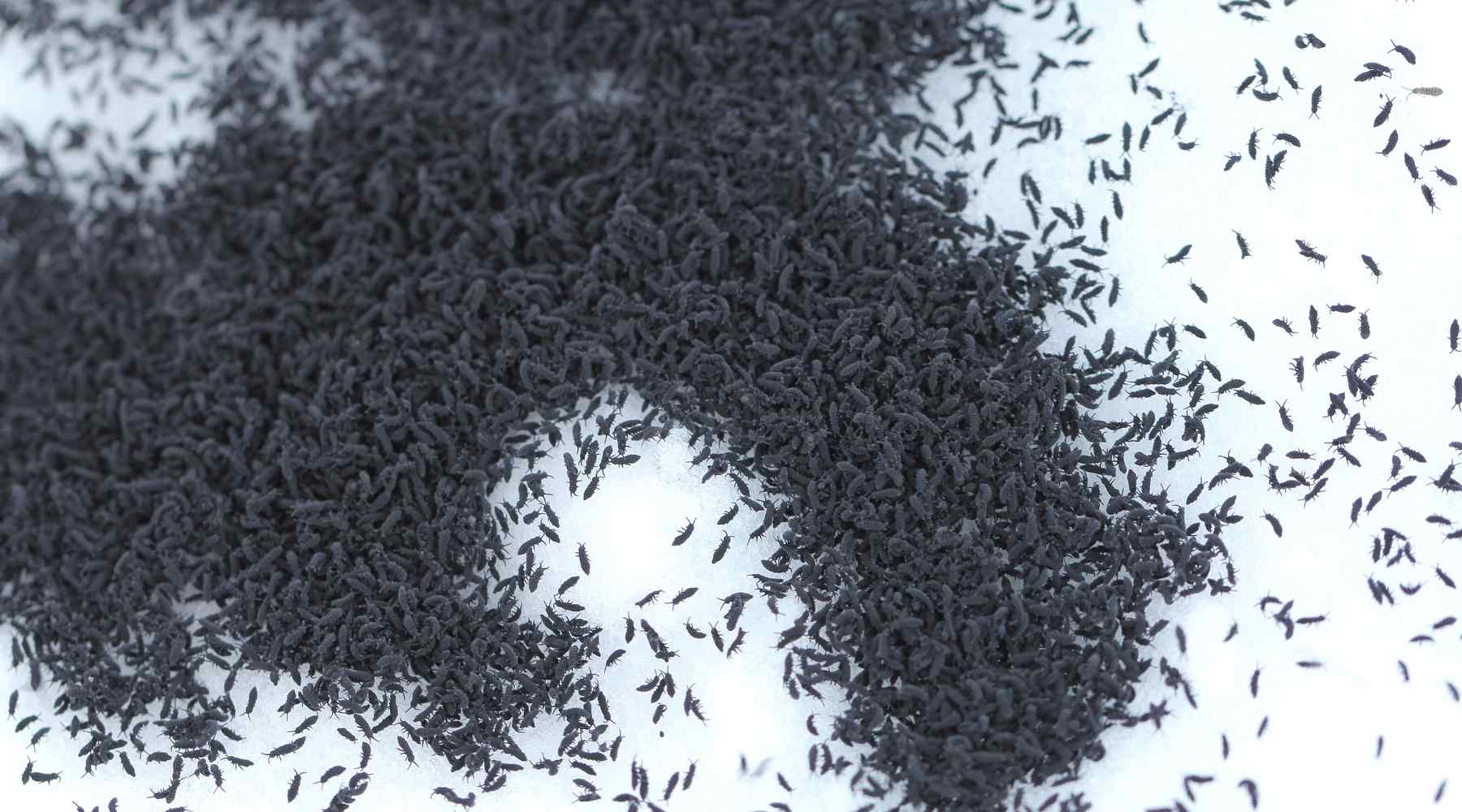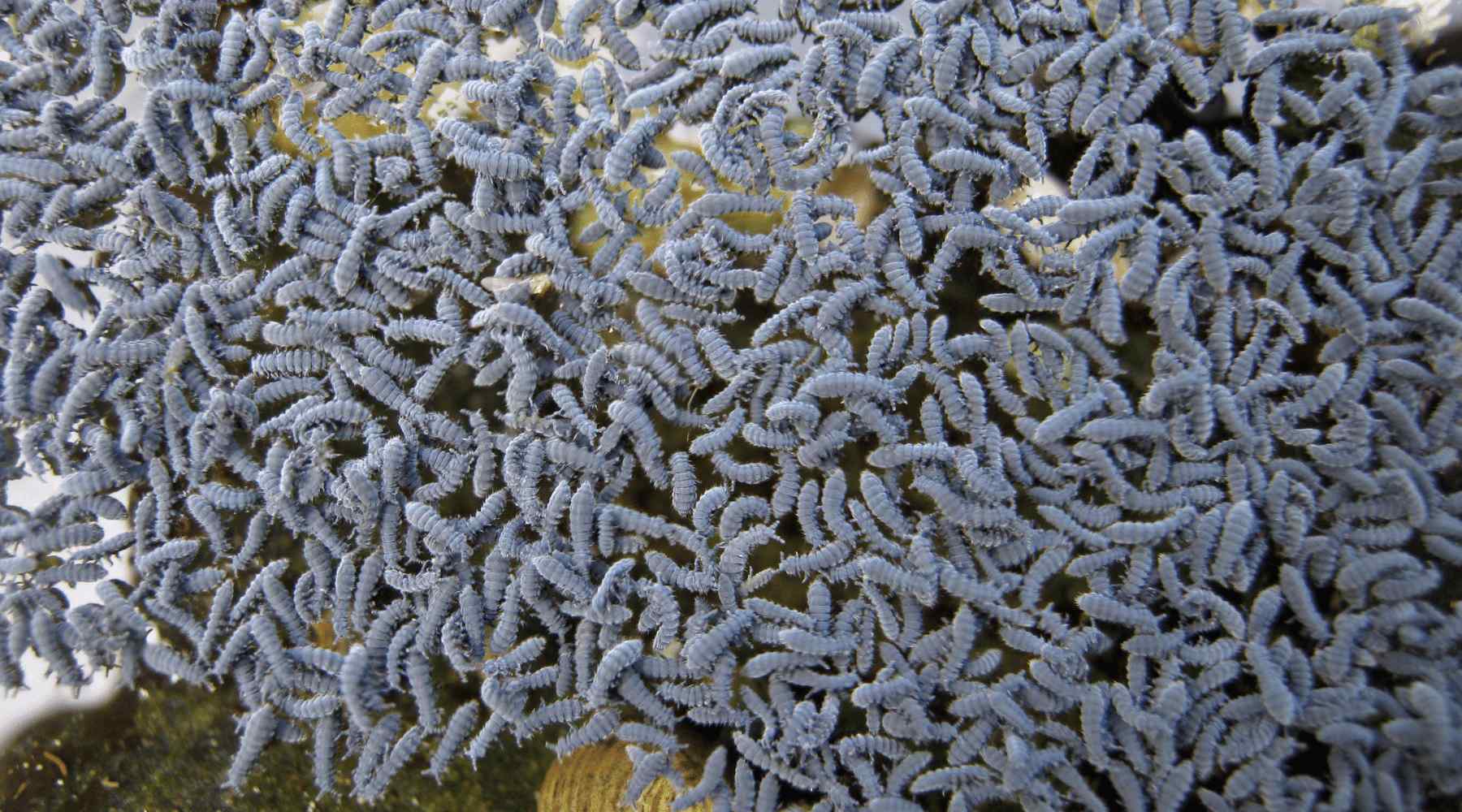Springtails: A Complete Guide

Springtails are a truly fascinating order of animals, with species found everywhere from Antarctica to the Namibian Desert and from the tips of Mount Everest to the very deepest depths of the Earth.
Not only are they essential to life on Earth but possibly one of the oldest terrestrial creatures known to man.
And if this wasn't enough, they have found themselves at the centre of a conspiracy theory…
In this guide, I will explain everything there is to know about Springtails.
I'll first take a look at some of the most common questions surrounding Springtails.
Then, I will examine their use in terrariums as well as best care practices.
Join me as we take a deep dive into the meso-world of Collembola.
Contents
- What Are Springtails?
- Common Misconceptions
- What Do Springtails Do?
- Why Are They Called Springtails?
- Notable Species
- Addressing The Conspiracy
- Where Do Springtails Come From?
- Using Springtails in Terrariums
- How to Care for Springtails
- Springtail FAQs
What are Springtails?
'Springtails' is a common name for species belonging to the order of animals Collembola.
They are small, omnivorous, moisture-loving detritivores that help break down organic materials in the earth.
Springtails exist in a range of sizes, shapes and colours – and have evolved to adapt to some of the wildest and most inhospitable conditions on Earth.
Springtails have six legs, often are less than 1mm in length and are a staggeringly ancient species.
And they are particularly famous for their jump – from which they derive their common name.
Though, before we get into the good stuff, I must tell you:
Springtails are wildly misunderstood creatures.
Let's dispel some common misconceptions.

Radical Anti-Springtail Fake News
They are NOT Insects.
In fact, they are one of only three hexapods that fall outside of the classification.
Unlike insects, they have internal mouth-parts and possess a 'furca' which gives them their superpower.
But more on this later.
They are NOT Microfauna
This is a term I myself have only recently come to clarify.
Microfauna are invisible to the naked eye.
Mesofauna, then, represents intermediate species such as the Springtail which we can see ourselves.
They are NOT Pests
This is the most crucial misunderstanding to examine.
Many gardening and houseplant blogs, websites and shops perpetuate the belief that springtails are a detrimental pest.
They write that springtails feed on roots, infest homes and in some cases even burrow into human skin.
These are shocking, yet incorrect claims.
In fact, as we’ll learn today, the beneficial properties of Springtails are overwhelming above any nuisance they may present.
So, What Do Springtails Do Exactly?
Well, they are complicated.
Often it is cited that they consume decaying organic matter and feed nutrients back into the soil.
This is partly true:
They do indeed play a crucial role in the cycle of nutrients on Earth, and they contribute to the formation of microstructures within a substrate.
However, they don’t strictly decompose organic matter themselves, but rather contribute to the process by fragmenting organic materials.

Why Are They Called ‘Springtails’?
The name ‘Springtail’ doesn’t leave much to the imagination.
Springtails have a fork-like ‘tail’ at the rear of their body known as a ‘furca’.
They deploy this tool in times of crisis to launch themselves up and away from potential threats and predators.
This appendage is the reason that they are sometimes mistaken as fleas.
One species of Collembola, in fact, has earned the common name ‘snow flea’. This is the Hypogastruna nivicola.
Their furcas, mouthparts and collaphores all distinguish them as a particularly unique species.
Where Do Springtails Come From?
Well, it’s a heck of a question.
In the year 1919 in a small village in northeast Scotland, a fossilised Collembola was discovered – a specimen thought to be around 410 million years old.
Blimey!
Collembola is thought to have evolved from sea-dwelling arthropods before becoming semi-aquatic and eventually fully terrestrial.
Though the absolute origin of the first species of Collembola is disputed and ultimately unknown.
 Where Can I Buy Springtails?
Where Can I Buy Springtails?
Springtails are incredibly popular, and thus they're not tricky to find available online!
You can find various reputable sellers via the links below:
If you're in the UK, you can find them here.
If you're in the USA, you can find them here.
Notable Species of Springtail
As I’ve mentioned there are an array of different Springtail species.
How many different species of Springtail are there?
Well, there are at the very least over 3600 species living today.
And, it is estimated that in an average square meter of earth, over 100,000 individual springtails may be found.
This is a staggeringly large number.
There are 4 suborders within the Collembola order:
- Entomobryopmorpha
This order contains species with typically elongated bodies, often covered in scales.
This is one of the largest suborders of Collembola.
One most notable species is Cryptopygus antarcticus.
This Springtail, unsurprisingly, lives in Antarctica. They are incredibly slow-growing and can even live for up to 10 years!
- Neelipleona
The ‘hunched’ order of Springtails.
Cryptic, globular and absolutely tiny.
The Megalothorax minimus is an exceptionally impressive name for one of the smallest species of Springtail recorded – clocking in at sub 0.6mm in length.
- Poduromorpha
Notably stubby and short-legged – these Springtails have a fascinating relationship with water.
Many species within the suborder have hugely varying shapes and sizes, different coats that naturally repel water.
Meanwhile, Podura aquatica lay their eggs into the depths of a water body, until their young hatch and launch themselves onto the surface on which they will remain.
- Symphypleona
The original globulars of the Springtail fandom.
These are regarded by many enthusiasts as the ‘cutest’ of the orders.
Squished, plump bodies and round, bulbous eyes compliment their dazzling array of colours and decals.
The Temeritas species have an exceptionally long antenna, while many in the suborder have elongated eversible sacs that they use to groom themselves
So really, they’re cute and they know it.
In addition to the above, studies have found species within the families Isotomidae, Neanuridae and Sminthuridae to exist within the microbial underworld of the Namibian Deserts.
Other species within the Desoria and Hypogastrura species were found enjoying life high up on the peaks of Mount Everest.
And if that wasn’t enough, the species Plutomurus ortobalaganensis has been recorded as the deepest living terrestrial animal, at a depth of over 2000 metres in the caves of Krubera-Voronja.

Addressing the Conspiracy
Do Springtails Bite and Can They Infest My Body?
It’s an odd question, isn’t it?
The answer to the above, simply, is:
No.
You might be wondering exactly why the question is being asked in the first place.
Well, there is a proliferation of people worldwide that believe a conspiracy theory that Springtails can not only bite humans but act as parasites.
But, is this the cry of those who don the tin-foil hat, or do Collembola harbour more menace than meets the eye?
Well, no. At least in one sense. We can say for sure that Springtails do not bite humans.
They have internal mouth-parts which would prevent them from doing so.
But, there’s more to this story.
Let’s take a look.

Springtails and Morgellons Disease
It’s not hard on the internet to come upon controversy.
Simply stumble upon an offensively outdated-looking yet frequented forum and you are bound to find it.
For Springtails, the problem surrounds a medically recognised condition known as Morgellons Disease.
This is purported by Healthline to be a skin condition often associated with Lyme disease, or other tick-borne illnesses.
Healthline, however, also notes that the disease “may have a psychological aspect” and that more studies are needed for clarification.
So where do Springtails come into all of this?
Well, Morgellons (MD) is associated often with a belief that one has been infected with parasites.
While some report infection of worms or ticks, others have taken to pointing the finger at Springtails.
Now HOLD ON there.
I know you love Springtails, but put down the pitchfork – let’s give these people a chance.
I took a little bit of a dive into the aforementioned antiquated forums to see if I could find any credible evidence that Springtails have ever infected a human body.
The Evidence
One forum-goer cited this collection of journal entries.
In it are a collection of reports, some of which pertain to Springtails.
I will highlight a few of these studies:
- "There is one case in the literature of a patient who was diagnosed as harbouring an ectoparasitic population of Collembola in her hair after complaining of an itchy scalp for over a year (Greenberg 1985). However, the source of the 'infection' was discovered to be a plant pot at the head of the patient's bed which supported a healthy colony of an unidentified entomobryid springtail. The patient was 'cured' by spraying the pots with insecticide." Greenberg, Z. (1985) cited from Hopkin, S.P. (1997:3)
This anecdote does suggest that Springtails were found on a patient’s scalp and that they did cause itchiness.
However, it seems to be because the patient slept next to a plant pot that hosted a colony of Springtails.
In this instance, it would be like sleeping atop an ant colony and complaining that they had infested your body.
There is a difference between ‘infecting’ and ‘being on’.
Those who claim Springtails ‘infect’ often complain of bites and burrowing.
But is there evidence of such instances?

Let’s continue.
- "We have Lepidocyrtus paradoxus from the butt of a woman who probably had an old fashioned picnic. Her doctor sent the specimens in. You can't be too careful when you tumble in the grass!" Snider, R. in Christiansen, K
- "Hurd (1954) accidentally infected his nasal sinuses with eggs of a species of Isotoma during fieldwork and passed about 50 live springtails from his nose some two months later. Pooters beware!" Cited from Hopkin, S.P. (1997:3):
- "... The statements by Martini (1952), pages 120 and 354 about collembolans are immaterial or plainly misleading. I already pointed out that collembolans do not have this ability to bite. Furthermore, Martini mentions Lepidocyrtus curvicollis as an occasional parasite sometimes assumed to nestle in human hairs. Martini's statement about the occurrence of springtails in human hair likely refers to the unusual case reported by Freche and Beille in the minutes of a meeting of the Academy of Sciences in Paris (1896, page 70)." Bryk, F. (1955:1822-1826)
Alright, that’s enough.
I’ve been scrolling for far too long through these reports and I am starting to become incredibly itchy.
Perhaps I am infected…
No, let’s be real.
Although some of these reports above may suggest the contrary, there is a consensus among their conclusions that the incredibly rare presence of Collembola on humans is incidental, that there is no evidence that they can bite or act parasitically towards humans and that in any instance they are easily removed.
It is largely believed that reports of Springtail infections and MD are a result of some form of psychological disorder – rather than something material.
The REAL conspiracy is quite possibly US-based exterminators pushing the idea that Springtails are dangerous.
If you want an ingenious take on the matter, look no further than this article by Chaos of Delight.
Now that we’re done with that, let’s move on to something a little less disgusting.

Using Springtails in Terrariums
Now for the fun part, and quite possibly what many of you came here for in the first place.
Springtails, like other species, play a crucial role in the nutrient cycle of soil and hence the greater ecosystem.
Within a terrarium or vivarium, this talent is especially appreciated and can add indefinite life to your environment.
Terrariums are famed for their low-maintenance lifestyles, whereby an interior ecosystem regulates the organisms within.
Plants, for example, take up nutrients and water via the substrate – transpire excess water from their leaves which then condenses onto the glassware and rains back down on the substrate for the process to repeat itself.
So, where do Springtails come in?
Your terrarium plants will invariably shed leaves and in part decay over time.
Rotting organic matter will begin to build up in the substrate.
In the wild, decaying organic matter needs to be converted back into nutrients for the ecosystem to continue.
Sometimes fungi will fulfil this role, and other times living organisms.
Springtails are one such organism.
Add in just a small quantity (Maybe 10-20) to your ecosystem and they will self-populate and self-regulate – yay!
Well, that was easy. So, let’s look at their care requirements, shall we?

How to Take Care of Springtails
Feeding
As we now know, Springtails help break down decaying materials and feed on the materials that fall to the substrate layer and rotting roots.
But, what if there’s nothing for them to eat?
Well, their population will invariably decline.
And this isn’t necessarily a bad thing.
It’s healthy for the population of a species to match that of its environment.
However, to keep your colony comfortable you can give them a little bio-boost every now and again.
I would recommend sterilised leaf litter or bug boost products to fulfil their needs.
Alternatively, you can sprinkle in a little yeast or tropical fish food.
Light
Collembola widely varies in their habitats as we have examined.
However, the most common species you will encounter for purchase online (Often Folsomia candida) will match the classic environment of a tropical terrarium.
So that’s indirect, yet bright light.
However, springtails will reside predominantly in the soil layer so you don’t really need to worry about whether or not they receive adequate light themselves – focus more on your flora.
Water
Most species of Collembola are moisture lovers and will appreciate a damp substrate in which to reside.
Again, typically, this is going to be the exact sort of substrate you are using within your closed terrarium.
If you’d like to know the ideal substrate mix for your terrarium, look no further

What can I use instead of Springtails?
If you can’t get your hands on these custodial critters (or simply don’t want to), don’t worry!
There are alternatives you can look to, such as:
- Isopods
- Earthworms
- Millipedes
And just before we finish, I’ll answer some of the hottest Springtail questions on the internet.
Answering Your Questions About Springtails
How Do I Add Springtails to My Terrarium?
There are two ways:
- Pour a little water into your Springtail container, and gently swish the springtails into a pool in one corner. Then, pour the little fellas into your container.
- Take a scoop of your Springtail-laden substrate and tip it into an open area of your terrarium.
Do I Need Springtails in My Terrarium?
Some would argue they are absolutely essential to a terrarium – or at least some form of mesofauna is.
I would say otherwise.
You can enjoy the hobby without the use of Springtails.
But, they will absolutely add years of life to your ecosystem and do a ton of the cleaning work for you.

Are Springtails Harmful to Humans?
No.
There is no solid evidence that they possess any sort of threat to humans.
Those leading the charge to the contrary are often trying to sell products, or are suffering from a separate disorder – often psychological.
These disorders whether material or not are serious and I recommend you consult your doctor if you believe yourself in any way afflicted.
How Long Do Springtails Live?
Their lifespan varies among species, some have been purported to live up to 10 years.
Colonies themselves can continue indefinitely.

Do Springtails Bite Humans?
Springtails have internal mouthparts, so, no.
They can't bite you.
There are articles online suggesting otherwise, but they never provide any sort of evidence outside of the anecdotal.
Where Do Springtails come from?
The oldest fossil of Collembola is reportedly around 410 million years old!
Since then, species of Springtail have spread worldwide – to the hottest, coldest, wettest, driest, tallest and deepest places of the earth.
Can Springtails Infest Your House?
Springtails can enter the home and appear in large numbers.
This is likely due to a moisture issue that has led to mould.
Springtails, ironically, will consume the mould however are often cited as the issue themselves.
Look to solve the original problem, not the symptom.
Call a plumber... or your landlord.
Can Springtails Escape my Terrarium?
If your terrarium doesn’t have a lid, yes they can!
For tropical ecosystems, I would always recommend using a lid so that you can retain a humid and balanced environment.
That being said, mesofauna is incentivised to stay inside the terrarium as that’s where all the goodies are.

How Can I Get Rid of Springtails?
As in the above question, be mindful of whether or not Springtails are the actual problem.
Is your house suffering from damp and mould issues?
If so, that’s your problem.
Springtails are a hugely important and beneficial species and one shouldn’t be quick to desire their snuffing.
Springtail or Flea? What am I looking at?
The best way to identify insects is by using a trusted source, whether that’s online, or in a good old-fashioned book.
Or, if you happen to know an entomologist – get in touch!
In the above article, I do describe Springtails in considerable length, so you should be able to get a clearer picture.
That’s It
Well, not really.
There is so much more to know about Springtails and fortunately, you have all kinds of avenues to explore them.
Just, stay away from those dodgy forums, mkay?
Have you used Springtails in your terrariums yet? Have they made a difference?
Let me know, down below.
- Joe Rees, Founder









Leave a comment